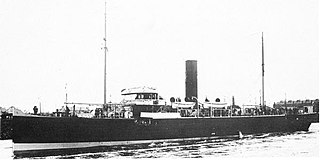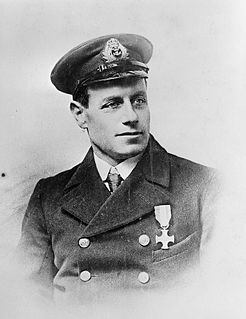Related Research Articles

Q-ships, also known as Q-boats, decoy vessels, special service ships, or mystery ships, were heavily armed merchant ships with concealed weaponry, designed to lure submarines into making surface attacks. This gave Q-ships the chance to open fire and sink them. The use of Q-ships contributed to the abandonment of cruiser rules restricting attacks on unarmed merchant ships and to the shift to unrestricted submarine warfare in the 20th century.
USS Gudgeon (SS-211) was the first American submarine to sink an enemy warship in World War II. One of the long-range Tambor-class vessels, Gudgeon scored 14 confirmed kills, placing her 15th on the honor roll of American submarines. She was declared overdue, presumed lost, on 7 June 1944.

HMS Trenchant is a Trafalgar-class nuclear-powered fleet submarine of the Royal Navy built by Vickers Shipbuilding, Barrow-in-Furness. Trenchant is in service and is based at HMNB Devonport. She is the third vessel and the second submarine of the Royal Navy to be named for the characteristic of vigour and incisiveness.
USS Sargo (SS-188), the lead ship of her class of submarine, was the first ship of the United States Navy to be named for the sargo.
This article describes the composition and actions of the Argentine naval forces in the Falklands War. For a list of naval forces from the United Kingdom, see British naval forces in the Falklands War.

Lieutenant Commander Malcolm David Wanklyn VC, DSO & Two Bars was a Second World War British Royal Navy submarine ace and one of the most successful submariners in the Western Allied navies. Wanklyn and his crew sank 16 enemy vessels.

Skipper Thomas Crisp VC, DSC, RNR was an English posthumous recipient of the Victoria Cross. Crisp, in civilian life a commercial fisherman operating from Lowestoft in Suffolk, earned his award after being killed during the defence of his vessel, the armed naval smack Nelson, in the North Sea against an attack from a German submarine in 1917.
HMT Warwick Deeping (H136) was a naval trawler of the British Royal Naval Patrol Service during World War II, sunk off the Isle of Wight in October 1940.

Although Australia was remote from the main battlefronts, there was considerable Axis naval activity in Australian waters during the Second World War. A total of 54 German and Japanese warships and submarines entered Australian waters between 1940 and 1945 and attacked ships, ports and other targets. Among the best-known attacks are the sinking of HMAS Sydney by a German raider in November 1941, the bombing of Darwin by Japanese naval aircraft in February 1942, and the Japanese midget submarine attack on Sydney Harbour in May 1942. In addition, many Allied merchant ships were damaged or sunk off the Australian coast by submarines and mines. Japanese submarines also shelled several Australian ports and submarine-based aircraft flew over several Australian capital cities.

In late May and early June 1942, during World War II, submarines belonging to the Imperial Japanese Navy made a series of attacks on the cities of Sydney and Newcastle in New South Wales, Australia. On the night of 31 May – 1 June, three Ko-hyoteki-class midget submarines, each with a two-member crew, entered Sydney Harbour, avoided the partially constructed Sydney Harbour anti-submarine boom net, and attempted to sink Allied warships. Two of the midget submarines were detected and attacked before they could engage any Allied vessels. The crew of M-14 scuttled their submarine, whilst M-21 was successfully attacked and sunk. The crew of M-21 killed themselves. These submarines were later recovered by the Allies. The third submarine attempted to torpedo the heavy cruiser USS Chicago, but instead sank the converted ferry HMAS Kuttabul, killing 21 sailors. This midget submarine's fate was unknown until 2006, when amateur scuba divers discovered the wreck off Sydney's northern beaches.

German submarine U-35 was a Type VIIA U-boat of Nazi Germany's Kriegsmarine. She was built three years before the start of World War II. The submarine was laid down on 2 March 1936 by Friedrich Krupp Germaniawerft at Kiel, launched on 24 September 1936, and commissioned on 3 November that year under the command of Kapitänleutnant (Kptlt.) Klaus Ewerth. The U-boat was featured on the cover of Life magazine on 16 October 1939, as in the days preceding, it "courteously" rescued all the sailors of a Greek ship that it was about to sink.

HMS Sportsman was a third-batch S-class submarine built for the Royal Navy during World War II. Completed in 1942, she spent most of the war serving in the Mediterranean Sea. After an initial patrol off Norway, she sank the heavy transport Général Bonaparte in the Mediterranean in 1943 and missed a French oil tanker. She was heavily damaged after a mistaken attack by an Allied bomber, and was sent east after repairs to participate in operations in the Black Sea. After the operation was cancelled, Sportsman patrolled the Aegean Sea, sending several Greek and German ships to the bottom. She sank the German transport SS Petrella in early 1944 despite it being clearly marked as a prisoner-of-war ship, killing 2,670 out of 3,173 Italians aboard. Sportsman sank several more ships, and suffered minor damage when she was detected and sighted while attempting to attack a convoy.

HMS Torbay (N79) was a T-class submarine of the Royal Navy. She was laid down at Chatham Dockyard and launched on 9 April 1940.

Naval trawlers are vessels built along the lines of a fishing trawler but fitted out for naval purposes; they were widely used during the First and Second World Wars. Some—known in the Royal Navy as "Admiralty trawlers"— were purpose-built to naval specifications, others adapted from civilian use. Fishing trawlers were particularly suited for many naval requirements because they were robust vessels designed to work heavy trawls in all types of weather, and had large clear working decks. A minesweeper could be created by replacing the trawl with a mine sweep. Adding depth charge racks on the deck, ASDIC below, and a 3-inch (76 mm) or 4-inch (102 mm) gun in the bow equipped the trawler for anti-submarine duties.

HNoMS Honningsvåg was a naval trawler that served throughout the Second World War as a patrol boat in the Royal Norwegian Navy. She was launched at the North Sea harbour of Wesermünde in Hanover, Germany in February 1940 as the fishing trawler Malangen and was captured by Norwegian militiamen at the North Norwegian port of Honningsvåg during her maiden fishing journey to the Barents Sea. Having taken part in the defence of Norway in 1940 she spent the rest of the war years patrolling the ocean off Iceland. She was decommissioned in 1946, sold to a civilian fishing company in 1947 and scrapped in 1973.

SM U-21 was a U-boat built for the Imperial German Navy shortly before World War I. The third of four Type U-19-class submarines, these were the first U-boats in German service to be equipped with diesel engines. U-21 was built between 1910 and October 1913 at the Kaiserliche Werft in Danzig. She was armed with four torpedo tubes and a single deck gun; a second gun was added during her career.
German submarine U-65 was a Type IXB U-boat of Nazi Germany's Kriegsmarine during World War II. Over the course of six war patrols between 9 April 1940 and 28 April 1941, she sank twelve ships and damaged three others for a total loss of 88,664 gross register tons (GRT).

Fremantle submarine base was the utilisation of Fremantle Harbour as a submarine base in World War II. The submarine base was second only to Pearl Harbor in the Pacific theater, with US, British and Dutch submarines operating from Fremantle during the war. US submarines operating from Fremantle accounted for approximately one quarter of all US submarine patrols in the Pacific.

The Japanese submarine I-175 was a Kaidai type of cruiser submarine of the KD6B sub-class. She was built for the Imperial Japanese Navy (IJN) during the mid-1930s.

I-7 was a J3 type submarine built by Kawasaki, Kobe, for the Imperial Japanese Navy in the 1930s. She was a large cruiser submarine that entered service in 1935 and served in World War II. She operated in support of the attack on Pearl Harbor, conducted anti-shipping patrols in the Indian Ocean, supported the Indian Ocean raid, and took part in the Guadalcanal campaign and the Aleutian Islands campaign. She was wrecked in the Aleutian Islands after a lengthy battle with the destroyer USS Monaghan (DD-354) in June 1943..
References
Citations
- 1 2 3 4 5 6 7 8 9 Abbey & Clifford 1980, p. 11.
- ↑ Stevens 2005, pp. 194-201.
- ↑ Stevens 2005, p. 201.
- 1 2 3 Hackett & Kingsepp 2010.
- ↑ Sturma 2011, p. 39.
- ↑ "Moruya Cemetery". Commonwealth War Graves Commission. Retrieved 20 August 2017.
- 1 2 Tim the Yowie Man 2017.
- ↑ "Dureenbee". Maritime heritage. Office of Environment & Heritage. Retrieved 29 July 2017.
- ↑ Sturma 2011, p. 40.
Works consulted
- Abbey, Tony; Clifford, Shirley (27 December 1980). "The Attack on the Dureenbee". The Canberra Times . p. 11. Retrieved 29 July 2017– via National Library of Australia.
- Hackett, Bob; Kingsepp, Sander (2010). "IJN Submarine I-175: Tabular Record of Movement". CombinedFleet.com.
- Stevens, David (2005). A Critical Vulnerability: The Impact of the Submarine Threat on Australia's Maritime Defence 1915–1954 (PDF). Canberra: Sea Power Centre – Australia. ISBN 0642296251.
- Sturma, Michael (2011). Surface and Destroy: The Submarine Gun War in the Pacific. Lexington, Ky.: University Press of Kentucky. ISBN 978-0-8131-2996-9.
- Tim the Yowie Man (29 July 2017). "Tim the Yowie Man: The Terrified Trawlermen". The Canberra Times. Retrieved 29 July 2017.